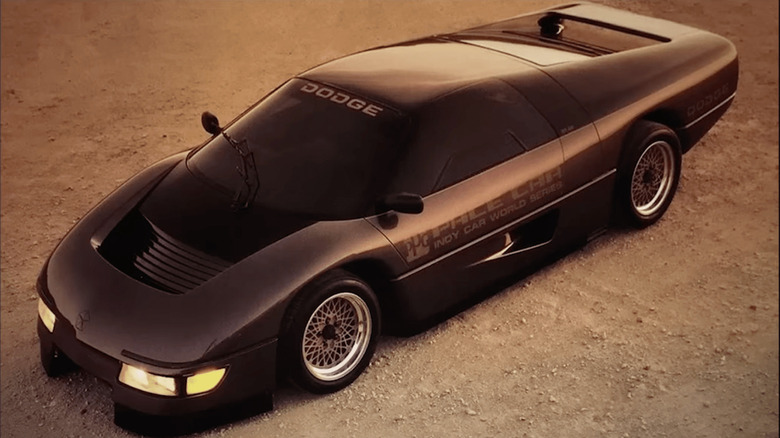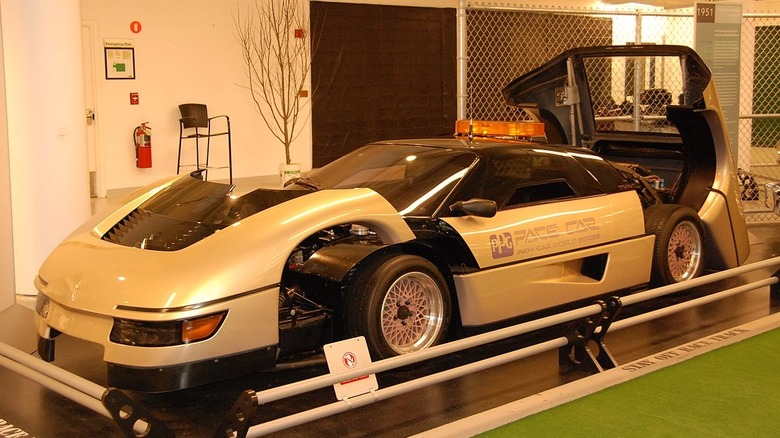The Wraith: Dodge's Sleek PPG Pace Car You've Probably Never Seen
1986 movie "The Wraith" definitely isn't going to win any Academy Awards, and some might even say that it's downright cheesy by modern standards. Still, it's well worth a watch by gearheads if only for the gratuitous racing scenes and rad cars.
The baddie in the film drives a customized C3 Corvette that's compiled from parts spanning at least three different model years. His gang's rides include a "Smokey and the Bandit"-era Trans-Am with a massive supercharger poking through the hood, an early Plymouth Barracuda, and a turbocharged Dodge Shelby Daytona.
However, none of those vehicles can come close to catching the protagonist: a character called the "Wraith," played by Charlie Sheen. Although it's referred to as a "Turbo Interceptor" in the film, the Wraith's whip is a real one-off, fully functional and mid-engine supercar produced by Dodge for an entirely different purpose than starring in a cult film.
In real life, the car is known as the M4S (short for Mid-engine, 4 cylinder, Sport), and its story begins in the early 1980s. The M4S was created with the dual mandate of showcasing Chrysler Corporation's latest technological advancements, as well as generating publicity as a pace car in a series of Indy car races. The completed vehicle was a collaboration between Chrysler's design team and independent Detroit-area subcontractors that did the heavy lifting on the build.
The Turbo Interceptors in the film were replicas
The M4S eschewed typical eight or 12-cylinder powerplants that were de rigueur at the time in favor of a compact 2.2-liter turbocharged four cylinder that would come to define Chrysler muscle cars and hot hatches of the 1980s, such as the Dodge Omni GLHS and Shelby Charger. In the M4S, this engine was tuned to approximately 440 horsepower, which pushed the car from 0-60 MPH in 4.1 seconds.
It was also incredibly aerodynamic, the result of relentless wind tunnel testing. The M4S's slippery bodywork boasted an incredibly low drag coefficient of 0.236, which was a big part of its 194.8 mph top speed. To put that figure in perspective, a brand new Corvette at the time sported a drag coefficient of 0.34.
After displaying the M4S at the Detroit Auto Show in early 1986, Dodge shipped it off to Arizona where "The Wraith" was being filmed. There are conflicting opinions as to whether the real M4S actually appeared in the film at all, or just in posters and other publicity materials.
What is known for certain is that the film crew had several M4S replicas that were basically fiberglass bodies sitting on a very basic, dune buggy-style frame. These replicas were tasked with performing all of the dangerous stunts and racing scenes. Some sources claim that the real M4S was used for close-up "hero" shots and a single non-risky driving scene, but the truth will likely never be known.
Like the Wraith, the M4S all but disappeared
At the time of the M4S's development, PPG — a supplier of paints and other coatings to the automotive industry — was sponsoring an open-wheel racing series called the CART PPG Indy Car World Series, which attracted celebrated drivers like Mario Andretti and Emerson Fittipaldi. Besides featuring prime racing talent, the series was also known for its outrageous pace cars.
Also known as safety cars, pace cars lead the field of race cars on parade laps at the beginning of a race, then remain on-call to limit the speed of racers in caution conditions such as a crash or foul weather. Most pace cars are fairly close to stock vehicles, perhaps with a flashy paint job or collection of stripes and stickers. The PPG pace cars, on the other hand, were flat out wild — heavily modified, and bore little resemblance to their mass-produced counterparts.
Of course, the M4S fit the PPG pace car mold like a glove, so possibly before filming "The Wraith" — but definitely afterward — the mid-engine supercar was a frequent fixture in the CART Indy Car series. By the late 1980s, the car sported a lighter silver color, and was retired to the Walter P. Chrysler museum.
After the museum closed in 2016, the car was dispatched into an unknown private collection. Earlier this year, a car purporting to be a genuine M4S popped up for sale on eBay with an opening bid of $290,000, and a buy-it-now price of $499,000. Upon closer investigation, that car turned out to be a replica based on a Porsche Boxster and was subsequently withdrawn from sale.
[Featured image by Corvair Owner via Wikimedia Commons | Cropped and scaled | CC BY-SA 2.0]

